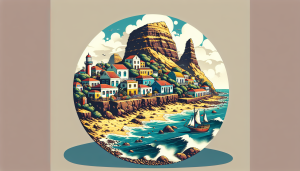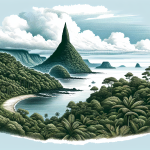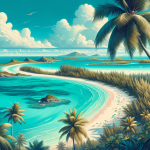Discovering the Hidden Gem of Cape Verde
Cape Verde, an enchanting archipelago off the northwest coast of Africa, offers a unique blend of African and Portuguese cultures, stunning landscapes, and a warm, tropical climate. This hidden gem is an ideal destination for travelers seeking a mix of adventure, relaxation, and cultural immersion. In this comprehensive guide, we’ll explore the allure of Cape Verde, from its pristine beaches and vibrant music scene to its volcanic landscapes and rich history. Whether you’re a seasoned traveler or a first-time visitor, Cape Verde promises a memorable experience that will leave you yearning for more.
The Islands of Cape Verde
Santiago Island
Santiago, the largest island in Cape Verde, serves as the cultural and political hub of the archipelago. The island’s capital, Praia, is a bustling city with a rich history and vibrant nightlife. Visitors can explore the historic Plateau district, home to colonial architecture, museums, and markets. For nature lovers, Santiago offers lush valleys, rugged mountains, and stunning beaches. The island’s interior is perfect for hiking, with trails leading to picturesque villages and breathtaking viewpoints.
Sal Island
Sal Island is renowned for its pristine white-sand beaches and crystal-clear waters, making it a paradise for beach lovers and water sports enthusiasts. The island’s main town, Santa Maria, boasts a lively atmosphere with beach bars, restaurants, and shops. Sal is also a popular destination for windsurfing, kitesurfing, and diving, thanks to its consistent trade winds and abundant marine life. Don’t miss the natural salt flats of Pedra de Lume, where you can float in the buoyant, mineral-rich waters.
Boa Vista Island
Boa Vista, the third-largest island in Cape Verde, is known for its stunning desert landscapes and expansive beaches. The island’s powdery sands and turquoise waters create a serene setting for relaxation and exploration. Visitors can take a quad bike tour to discover the island’s hidden gems, including the Viana Desert and the shipwreck of Cabo Santa Maria. Boa Vista is also a nesting site for loggerhead sea turtles, offering a unique opportunity to witness these majestic creatures in their natural habitat.
Fogo Island
Fogo Island, dominated by its imposing volcano, is a must-visit for adventure seekers and nature enthusiasts. The island’s most iconic feature is Pico do Fogo, an active volcano that last erupted in 2014. Visitors can embark on a challenging hike to the summit, where they’ll be rewarded with panoramic views of the island and the surrounding ocean. The fertile volcanic soil supports vineyards and coffee plantations, offering a taste of the island’s unique agricultural products. The charming town of São Filipe, with its cobblestone streets and colonial architecture, provides a glimpse into Fogo’s rich history.
São Vicente Island
São Vicente, known for its vibrant cultural scene, is the birthplace of Cesária Évora, the “Barefoot Diva” of Cape Verdean music. The island’s capital, Mindelo, is a lively port city with a thriving arts and music scene. Visitors can explore the bustling markets, colorful buildings, and lively bars that make Mindelo a cultural hotspot. São Vicente also hosts the annual Carnival, a vibrant celebration of music, dance, and tradition. For outdoor enthusiasts, the island offers hiking trails, pristine beaches, and excellent windsurfing conditions.
Cape Verdean Culture
Music and Dance
Cape Verde’s rich musical heritage is deeply rooted in its African and Portuguese influences. The most famous genre is morna, a soulful and melancholic style popularized by Cesária Évora. Other traditional genres include coladeira, funaná, and batuque. Music and dance are integral to Cape Verdean culture, with festivals and celebrations featuring live performances, dancing, and vibrant costumes. Visitors can experience the island’s musical traditions at local bars, restaurants, and cultural events.
Cuisine
Cape Verdean cuisine reflects the archipelago’s diverse cultural influences and abundant natural resources. The staple dish is cachupa, a hearty stew made with corn, beans, vegetables, and meat or fish. Seafood plays a significant role in the local diet, with fresh catches like tuna, lobster, and octopus featured prominently in many dishes. Other popular foods include pastel (fried pastry filled with fish or meat), feijoada (bean stew with pork), and bolo de coco (coconut cake). Visitors can savor Cape Verdean flavors at local restaurants and street food vendors.
Festivals and Traditions
Cape Verdeans celebrate a variety of festivals and traditions throughout the year, showcasing their rich cultural heritage. One of the most significant events is Carnival, particularly in Mindelo, where the streets come alive with colorful parades, music, and dancing. Other notable festivals include the Gamboa Festival in Praia, the Baía das Gatas Music Festival on São Vicente, and the São João Festival in Porto Novo. These events provide visitors with an opportunity to immerse themselves in Cape Verdean culture and experience the island’s vibrant spirit.
Outdoor Activities in Cape Verde
Water Sports
With its stunning coastline and favorable weather conditions, Cape Verde is a haven for water sports enthusiasts. The archipelago offers excellent opportunities for surfing, windsurfing, kitesurfing, and diving. Sal and Boa Vista are particularly popular for their consistent trade winds and clear waters. Divers can explore underwater caves, shipwrecks, and vibrant coral reefs teeming with marine life. Whether you’re a beginner or an experienced water sports enthusiast, Cape Verde’s diverse offerings cater to all skill levels.
Hiking and Trekking
Cape Verde’s varied landscapes provide a paradise for hikers and trekkers. Santiago, Santo Antão, and Fogo islands offer some of the best hiking trails, ranging from gentle walks to challenging climbs. On Santiago, hikers can explore lush valleys, verdant hills, and traditional villages. Santo Antão is known for its dramatic landscapes, with steep cliffs, terraced fields, and lush forests. Fogo’s Pico do Fogo, an active volcano, offers a challenging ascent with rewarding views. Guided tours and self-guided routes are available for those looking to explore the islands on foot.
Wildlife Watching
Cape Verde’s unique ecosystem supports a diverse range of wildlife, making it an ideal destination for nature enthusiasts. Birdwatchers can spot a variety of species, including the Cape Verde warbler, red-billed tropicbird, and brown booby. The islands are also home to several endemic species, such as the Raso lark and the Cape Verde giant gecko. Marine life is abundant, with opportunities to see dolphins, whales, and sea turtles. Boa Vista and Sal are particularly known for their sea turtle nesting sites, where visitors can witness these magnificent creatures laying their eggs.
Practical Information for Travelers
Getting There
Cape Verde is accessible by air, with several international flights connecting the islands to Europe, Africa, and the Americas. The main international airports are Amílcar Cabral International Airport on Sal, Nelson Mandela International Airport on Santiago, and Aristides Pereira International Airport on Boa Vista. Direct flights are available from major cities such as Lisbon, Paris, and Amsterdam. Inter-island travel is facilitated by domestic flights and ferries, allowing visitors to explore multiple islands during their stay.
Accommodation
Cape Verde offers a range of accommodation options to suit different budgets and preferences. Visitors can choose from luxury resorts, boutique hotels, guesthouses, and self-catering apartments. Sal and Boa Vista are known for their all-inclusive resorts, while Santiago and São Vicente offer a mix of hotels and guesthouses. For a more authentic experience, travelers can stay in traditional Cape Verdean homes or eco-lodges. Booking in advance is recommended, especially during peak tourist seasons and festival periods.
Health and Safety
Cape Verde is generally considered a safe destination for travelers, with a low crime rate and friendly locals. However, it’s always wise to take standard precautions, such as avoiding isolated areas at night and keeping valuables secure. Health facilities are available on the main islands, but it’s advisable to have travel insurance that covers medical expenses. Visitors should also be aware of the potential for tropical diseases and take necessary precautions, such as using insect repellent and staying hydrated. The tap water is not always safe to drink, so it’s recommended to use bottled or filtered water.
Currency and Language
The official currency of Cape Verde is the Cape Verdean escudo (CVE), which is pegged to the euro. Euros are widely accepted, and ATMs are available in major towns and cities. Credit cards are accepted in hotels and larger establishments, but it’s advisable to carry cash for smaller transactions and remote areas. The official language is Portuguese, but Cape Verdean Creole (Kriolu) is widely spoken. English is not commonly spoken, so learning a few basic phrases in Portuguese or Creole can be helpful for communication.
Conclusion
Cape Verde, with its diverse landscapes, rich culture, and warm hospitality, offers an unforgettable travel experience. From the volcanic peaks of Fogo to the pristine beaches of Sal and Boa Vista, each island has its unique charm and attractions. Whether you’re seeking adventure, relaxation, or cultural immersion, Cape Verde has something for everyone. Plan your trip to this hidden gem and discover the magic of Cape Verde for yourself.
For more information on Cape Verde’s tourism and travel guides, visit Cape Verde Tourism.








